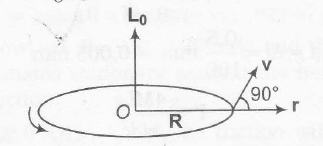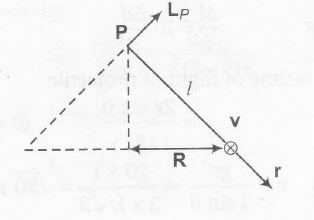Answer:
Option C
Explanation:
Angular momentum of a particle about a
point is given by :
$L = r \times p =m (r \times v)$
For $L_{0}$

|L|=$(mvr \sin \theta)=m(R \omega)(R) \sin 90^{0}$
=$mR^{2} \omega$= constant
Direction of $L_{0}$ is always upwards , Therefore , complete $L_{0}$ is constant , both in magnitude as well as direction
For $L_{p}$

$|L_{p}|=(mvr \sin \theta)$
=$(m)(R\omega)(l) \sin90^{0}$
=$(mRl \omega)$
magnitude of $L_{p}$ will remain constant but direction of $L_{p}$ keeps on changing